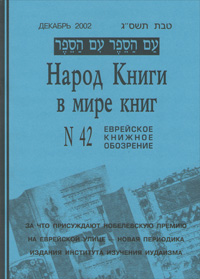The People of the Book in the World of Books is a Russian bimonthly publication for serious readers with Jewish interests. Our English website includes only the summaries of the published articles. To access the complete text of them, please visit the Russian version of this website.

|
||
|
This issue of the magazine includes:
• Review: If It Happened Once... The 2002 Nobel Prize for Literature was awarded to Hungarian-Jewish writer Imre Kertesz, Auschwitz survivor. Most of his books are dedicated to the memory of the Holocaust. Only one of his books has been published in Russian. The Nobel Committee's decision will give publishers the motivation to present to the Russian readers more of the writings of this interesting, traditional European-style author. • Survey: New Periodicals on the “Jewish Street” This critical analysis of the new Jewish magazines from Moscow, Odessa, Kharkov and Kishinev provides an opportunity to judge the level of intellectual maturity of Jewish community life in the post-Soviet countries. • Response: Quality Is As Usual The invention of Daguerre and Niepce changed the world. As everyone knows, this happened more than 150 years ago. And historians of the 20th century had at their disposal an absolutely new instrument for the study of historical reality. A new concept emerged—photo-research, and the book genre “illustrated history” now signifies something essentially different from what it meant in the past. The album The Jews in the Twentieth Century is an excellent example of what photography is—not simply pictures that accompany the text, but a special language. Carefully chosen, thoughtfully arranged in a definite sequence, the close-ups at times make it possible to say much more about the dramatic history of the past century (in this case—Jewish history) than a text—even the text of such an acknowledged master of popular historical monographs as Martin Gilbert. The original English version of the album appeared in London only a year ago. This year editions were published in several more European languages, including Russian. The elegant design, the outstanding printing work (printed in Italy!)—so we want to rejoice, we lived to see it, the Russian reader receives a beautiful book, a book-event, practically at the same time as the Western reader... Alas, there is no reason to rejoice. Again (as so often before!) the most interesting material and irreproachable printing are combined in the new album with a wretched Russian translation. The mistakes are typical. As always, geographic names and proper names are garbled—Bar-Kochba is transformed into “Bar-Kotchba”, Rabbi Kook—into “Rabbi Koh-ohk”, Molly Picon—into “Molly Paikon”, Alter Kacyzne—into “Alter Kasizne”. And so on and so forth. Plus, of course, a multitude of other minor and major mistakes, inaccuracies, and simply nonsense, such as the assertion that “Òhe Torah is the code of Jewish laws, established on the basis of the Mosaic Pentateuch”, or the information that the founder of Yiddish literature was “Mendel Mokher-Seforim”, which means “Young Mendel, book seller”, and “Mendel's real name was Yakov Abramovich Sholom”. A special exhibit for collectors of translation “pearls”: “American Jewish United Committee of Distribution 'The Juncture'”. There at the Moscow publishing house Art-Rodnik, have they really never heard of the “bourgeois-nationalist organization 'The Joint'”?.. The indignant words must be expressed in writing: How long will this go on?! How long will these monstrosities, resulting from the efforts of illiterate translators, incompetent editors, and irresponsible publishers, be dumped on the Russian book market, instead of high-quality Jewish editions? Unfortunately, the answer is simple. As long as the public reaction to them is not general indignation and ridicule, but apathetic silence or something worse than that—unthinking delight and encouraging applause. And now—you expect that the standard wave of laudatory reviews for the new album will sweep over the Jewish newspapers of cities and towns, of the sort that accompanies nearly every publication on Jewish history and culture that is at all worthy of note. And indeed—the book is handsome, the paper is glossy, there are many pictures. And all of Jews! It wouldn’t surprise us even if we were to see some rich organization—for example, that very same “Juncture” committee—go and buy half the edition and send it to Jewish community libraries. And the publisher is happy—the reviews are good, it's a commercial success. So why get so worked up over such a trifle as a literate translation? • Synopses: New Biography of Ilya Erenburg The biography, written by the American historian Joshua Rubinstein and published in Russian in St. Petersburg in 2002, gives readers a new, sometimes unusual, perspective on the life of this famous Soviet writer and public figure. • Publishers and Publishing Projects: The Institute of Jewish Studies in the C.I.S. The Institute of Jewish Studies in the C.I.S. was born in February 1989 when Rabbi Adin Steinsaltz founded the Makor Chaim Yeshiva in Moscow, the first independent Jewish religious school in the USSR for many years. The most significant project of the organization became the publishing of the multi-volume Russian edition of the Babylonian Talmud with commentaries. The article about the Institute's activities is followed by the complete bibliography of its publications. • Jewish Calendar of Significant Dates: January–February 2003 • Bibliography: 65 New Books |


